- Quick Read
- Deep Read ( 7 Min. )

Why is Christian Science in our name?
Our name is about honesty. The Monitor is owned by The Christian Science Church, and we’ve always been transparent about that.
The Church publishes the Monitor because it sees good journalism as vital to progress in the world. Since 1908, we’ve aimed “to injure no man, but to bless all mankind,” as our founder, Mary Baker Eddy, put it.
Here, you’ll find award-winning journalism not driven by commercial influences – a news organization that takes seriously its mission to uplift the world by seeking solutions and finding reasons for credible hope.
Explore values journalism About usIn Today’s Issue
Monitor Daily Podcast
- Follow us:
- Apple Podcasts
- Spotify
- RSS Feed
- Download
TODAY’S INTRO
Messi is coming to the US. Just sit back and enjoy.
 Mark Sappenfield
Mark Sappenfield
Lionel Messi is coming to America. By this point, many of you will have heard. At the end of one of the most storied careers in soccer history, the legend and World Cup hero is coming to Miami to play in Major League Soccer.
Here is where we in the press insert countless breathless and portentous stories about what this means for American soccer, for America’s top professional league, and for Mr. Messi’s career.
At such a momentous moment, it is natural to ask momentous questions. When the world is gripped in the first giddy moments of excitement, we often either bathe in the rosy glow of optimism or assume the practiced role of the skeptic. Mr. Messi’s arrival will be a watershed moment for American soccer, or Mr. Messi is simply cashing in one last time before retirement. He shows that MLS has arrived, or that it is still just a rest home for stars past their prime.
To this, I might say: Who cares? None of us really have any clue what effect Mr. Messi will have on American soccer. Yet what a joy it will be to watch him. Here is a man who has a rightful place in the conversation about the best players ever to kick a soccer ball.
When Pelé came to the United States in 1975, he was 50 years too early. Soccer was still a punchline. Today, Mr. Messi can be enjoyed by a nation that now has some appropriate appreciation of his genius. What will he change? Even at this stage of his career, he can still change hearts, offering emphatic testimony that soccer is indeed the beautiful game.
Share this article
Link copied.

Help fund Monitor journalism for $11/ month
Already a subscriber? Login

Monitor journalism changes lives because we open that too-small box that most people think they live in. We believe news can and should expand a sense of identity and possibility beyond narrow conventional expectations.
Our work isn't possible without your support.
In major win for voting rights, Supreme Court sides with Black Alabamians
In one of the biggest rulings of this term so far, the U.S. Supreme Court upheld a key section of the Voting Rights Act. The case has important implications for both 2024 elections and democracy overall.

-
Harry Bruinius Staff writer
-
Sophie Hills Staff writer
In a fractured, and surprising, ruling Thursday, the U.S. Supreme Court blocked a potentially discriminatory Alabama voting map. In doing so, it preserved a key section of the Voting Rights Act.
One of several cases this term examining – and potentially recasting – the function of race in American law and society, the case had been closely watched. In 2021, Alabama adopted a new congressional map with only one majority-Black district. It presented a head-on challenge to Section 2 of the Voting Rights Act.
The landmark civil rights law banned discriminatory voting practices adopted by Southern states in the Jim Crow era. Section 2 says that states may not “deny or abridge the right of any citizen of the United States to vote on account of race or color.” In Thursday’s decision, Chief Justice John Roberts – joined by the court’s liberal wing and Justice Brett Kavanaugh – upheld a district court ruling that the Alabama law likely violates Section 2.
The decision makes clear that Chief Justice Roberts and Justice Kavanaugh are the ideological center of the current Supreme Court.
“At least three of the other four [conservative] justices ... would want to bring wholesale changes to American constitutional law,” says Mark Graber, a professor of law and politics at the University of Maryland. Justices Roberts and Kavanaugh “want to go slower.”
In major win for voting rights, Supreme Court sides with Black Alabamians
In a fractured, and surprising, ruling Thursday morning, the U.S. Supreme Court blocked a potentially discriminatory Alabama voting map. In doing so, the justices preserved a key section of the Voting Rights Act.
One of several cases this term examining – and potentially recasting – the function of race in American law and society, the case, Allen v. Milligan, had been closely watched. Specifically, the case concerned a challenge to a 2021 Alabama law called HB1, in which the state adopted a new congressional district map with only one majority-Black district, even though Black voters constitute 27% of the state’s population. It presented a head-on challenge to Section 2 of the Voting Rights Act.
The landmark civil rights law banned discriminatory voting practices adopted by many Southern states in the Jim Crow era. Section 2 says that states may not “deny or abridge the right of any citizen of the United States to vote on account of race or color.” Under the leadership of Chief Justice John Roberts, the high court has been kind to laws restricting voting access, notably in 2013 when he wrote the majority opinion in Shelby County v. Holder, striking down a different section of the landmark civil rights act.
But in today’s Milligan decision, Chief Justice Roberts – joined by the court’s three-justice liberal wing and Justice Brett Kavanaugh – upheld a district court ruling that the Alabama law likely violates Section 2.
“The heart of these cases is not about the law as it exists. It is about Alabama’s attempt to remake our Section 2 jurisprudence anew,” wrote Chief Justice Roberts.
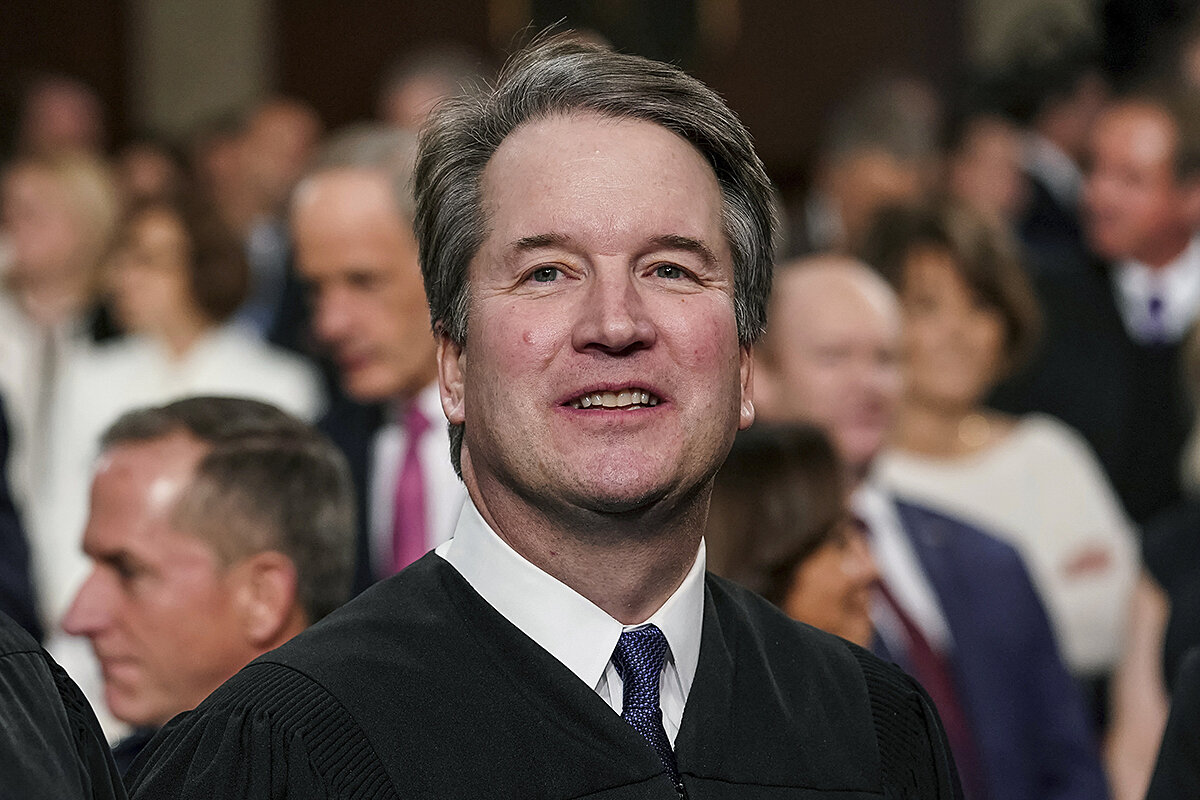
The ruling “does not diminish or disregard the concern that Section 2 may impermissibly elevate race” in state redistricting processes, he added. “Instead, the Court simply holds that a faithful application of precedent and a fair reading of the record do not bear those concerns out here.”
Alabama’s electoral map
“I am disappointed in today’s Supreme Court opinion but it remains the commitment of the Secretary of State’s Office to comply with all applicable election laws,” Alabama Secretary of State Wes Allen said in a statement after the ruling.
The case begins with the 2020 Census, which found that Alabama’s population had grown about 5% and was now one-quarter Black. In redrawing the state’s congressional map, lawmakers settled on a plan largely resembling the previous decade’s map: seven districts, with only one being majority-Black.
The state adopted that map by passing HB1, but local civil rights groups challenged the law, arguing that it violated Section 2 because the state could, and should, have created a second majority-Black district. In January 2022, a three-judge federal district court panel agreed that the map likely violated the Voting Rights Act and ordered Alabama to draw a new map. The state then filed an emergency appeal to the Supreme Court. The justices stayed the district court ruling while scheduling the appeal for a hearing on the merits last October, allowing the new map to be used in the 2022 midterm elections.
Arguments in the case focused on disagreements over when exactly voting rights are sufficiently harmed to constitute a Voting Rights Act violation. But notably, Alabama not only argued that its law didn’t violate Section 2 but also claimed that Section 2 challenges should now be evaluated per a “race-neutral benchmark” that uses modern computer technology to draw maps that don’t consider race at all. Because the state did this, Alabama argued, its map couldn’t possibly be abridging Alabamians’ voting rights on account of race.
In a dissent, Justice Clarence Thomas agreed with Alabama’s argument, writing that Section 2 “does not guarantee [racially] proportional representation.” In fact, the Constitution prohibits considering race in this way, he added: “to avoid setting Section 2 on a collision course with the Constitution, courts must apply a race-neutral benchmark in assessing any [racial gerrymandering] claim.”
In his majority opinion, Chief Justice Roberts responded that “forcing [racially] proportional representation” is already unlawful under the court’s Section 2 precedents. “The contention that mapmakers must be entirely ‘blind’ to race has no footing in our Section 2 case law,” he added.
Justice Kavanaugh, in a separate concurrence, supported the chief justice’s interpretations of the court’s Section 2 jurisprudence – though he didn’t join a section of the majority opinion undressing Alabama’s proposed race-neutral benchmark practice.
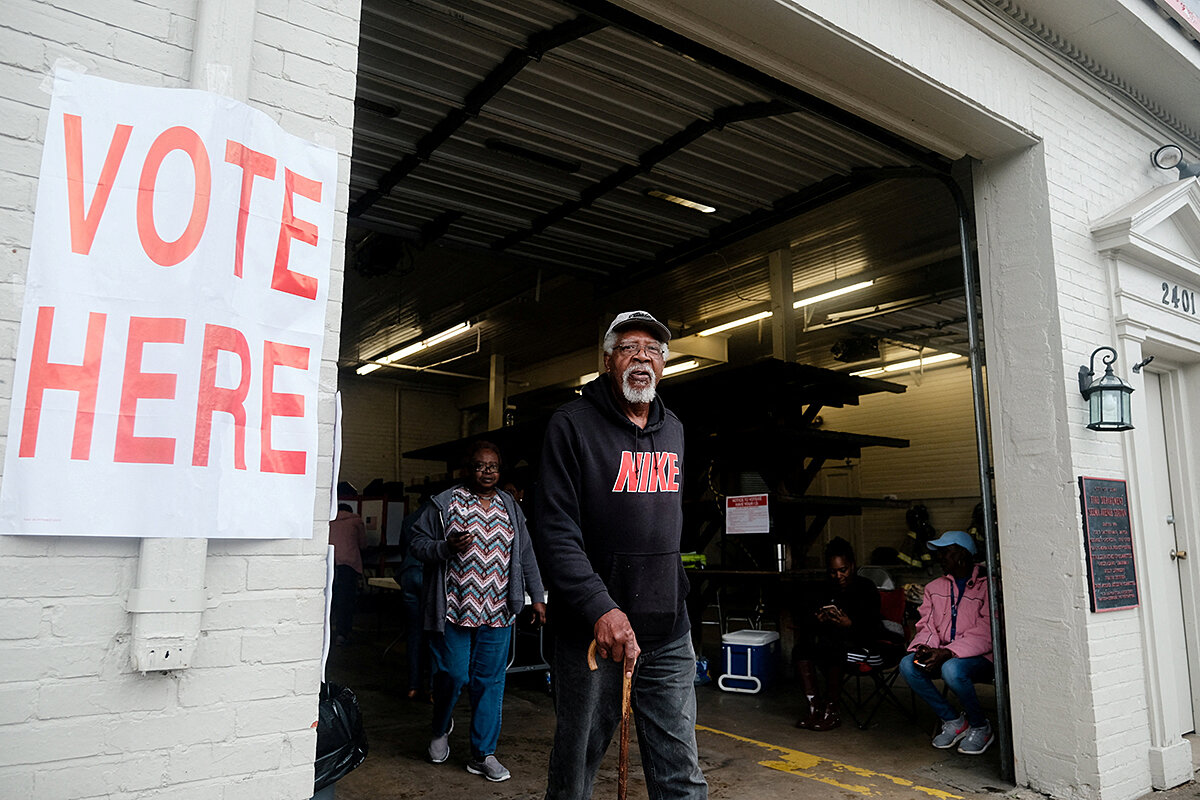
“The Court’s precedents [do] not mandate a proportional number of majority-minority districts,” he wrote. But, he added, “the authority to conduct race-based redistricting cannot extend indefinitely into the future.”
With the court’s three other conservative justices joining parts of Justice Thomas’ dissent and Justice Samuel Alito also writing a separate dissent, the Milligan decision makes clear that Chief Justice Roberts and Justice Kavanaugh are the ideological center of the current Supreme Court, says Mark Graber, a professor of law and politics at the University of Maryland.
“At least three of the other four [conservative] justices ... would want to bring wholesale changes to American constitutional law,” he adds. Justices Roberts and Kavanaugh “want to go slower.”
“It wouldn’t surprise me if we’re going to see affirmative action overruled later this term,” he continues. So upholding the Voting Rights Act ruling today could be seen as “Roberts not wanting to do too much, and this way both he and Kavanaugh can present themselves as moderates, and that’s very important to both of them.”
“Absolutely stunning development”
The immediate reaction to the court’s ruling was, for voting rights experts, surprise and delight.
“This is an absolutely stunning development,” wrote Nicholas Stephanopoulos, of Harvard Law School, on the Election Law Blog. “I would never have expected this Court to rule fully in favor of the plaintiffs in a Section 2 racial vote dilution case.”
In the shorter term, the Milligan decision could have a significant effect on the 2024 elections. Lawsuits challenging maps in states like Louisiana and Georgia have been stayed while the Supreme Court considered the Alabama case. Now voting rights groups like the American Civil Liberties Union, which has six redistricting cases active in federal courts, will push to resolve those cases before voters go to the polls.
“This was a huge moment,” says Sophia Lin Lakin, co-director of the ACLU’s Voting Rights Project.
“You’re probably going to see litigants moving forward, and moving pretty rapidly,” she adds. “With the lifting of stays that were put in place, we’ll be moving forward pretty quickly to try to get in place fair maps that don’t dilute the voting power of minority communities.”
Other voting rights observers believe the ramifications of Milligan could play out well beyond 2024.
“At its core this is a issue of, do racial and ethnic minorities in the South get to elect federal representatives that, you know, serve their communities, that are elected from their communities,” says David de la Fuente, a senior political analyst at the nonpartisan Third Way in Washington. He sees potential implications for redistricting maps in Arkansas and South Carolina, as well as states like Georgia and Louisiana with cases already pending.
“We don’t know how fast the states are going to be forced to act on this,” he says, adding that he could see an argument for drawing up to four additional Latino-majority districts in Texas. “I do think Alabama and Louisiana will have to redraw pretty fast. But some of the bigger, I guess, prizes like Georgia, Florida, Texas – this might be playing out for the next decade.”
Future of voting rights law
While the opinion is unquestionably a win for voting rights advocates, most court watchers don’t view it as a sea change in voting rights law. In their view, it’s a court preserving the status quo of a legal landscape where the Voting Rights Act has become increasingly difficult to enforce.
It would be imprudent to assume that this represents a “major turnaround in the court’s general skepticism about voting rights claims,” says Russell Wheeler, a senior fellow at the Brookings Institution in Washington. “By itself, this does not indicate a fundamental redirection on the part of at least the two ... somewhat conservative Justices Kavanaugh and Roberts.”
A 1993 precedent that states can’t draw new districts based solely on race, unless they have a compelling reason, for example, is still in place. It just happened to be clear enough, in Alabama’s case, that race could be given more consideration without it becoming the predominant consideration. And the majority opinion notes that it’s a rare win. Since 2010, wrote Chief Justice Roberts, “fewer than ten Section 2 suits” have been successful in federal courts.
“That’s an implicit recognition that the court’s existing precedents already made Section 2 hard to use,” said Michael Li, a redistricting expert at the Brennan Center for Justice, on Twitter.
“While Section 2 does really important, vital work in places like [central] Alabama, there are many places where its effects are much more limited despite the fact that those places also often have significant racial discrimination,” he added.
More challenges to the Voting Rights Act, and Section 2 specifically, are likely, experts say. And depending on the facts and arguments in those cases, the voting rights landscape could look very different in a few years.
Milligan shows that “at least two members of the conservative majority on the Supreme Court are open and receptive to some claims of racial gerrymandering,” says Mr. Wheeler.
“The African American plaintiffs should be happy about it,” he adds, “but I wouldn’t say that by itself this is a cause for viewing that, you know, the struggle is over.”

The Explainer
Canadian fires offer public safety lesson for Eastern US
The severity of Canadian wildfire smoke has startled the United States and may prompt Eastern communities to draw safety lessons from the fire-prone West.

- Quick Read
- Deep Read ( 4 Min. )
Smoke from Canadian wildfires is unsettling communities across the Midwest and Northeast regions of the United States, prompting altered activities for children and warnings for adults.
New York City notched its worst-on-record air pollution levels. Officials in both countries urge affected residents to stay inside and use N95-style masks outdoors.
Wildfires can regenerate natural landscapes and are common in Canada. But it has been a harsh start to the fire season. Though individual fires are difficult to attribute directly to climate change, much of Canada has had a warm and dry spring – a combination that becomes more likely due to warming global temperatures.
Exposure to massive wildfires “used to be kind of a once-in-a-lifetime thing,” says Keith Bein, an air quality researcher at the University of California, Davis. “Now it’s happening more frequently and it’s becoming almost every season.”
Fire veterans out West may have lessons to share with their friends on the East Coast. Preparation and public awareness are key, they say.
Missoula, Montana, holds an annual Wildfire Smoke Ready Week. And California has a pilot program for public “clean air centers” for those vulnerable to smoke – resembling how “cooling centers” offer respite from extreme heat.
Canadian fires offer public safety lesson for Eastern US
Smoke from Canadian wildfires has shrouded the New York City skyline in a Halloween haze. The bitter air has reached the Great Lakes region of the United States and the mid-Atlantic, prompting public health warnings.
New York City notched its worst-on-record air pollution levels, exceeding what San Francisco experienced during 2018 wildfires in California. And air was deemed “very unhealthy” in the nation’s capital Thursday.
The severity of the smoke has startled communities living far from the fire-prone North American West, raising questions around local preparedness and safety. Here’s a look at the scope of the fires and alerts.
How unusual are the Canadian fires, and what’s expected for the fire season ahead?
Wildfires can regenerate natural landscapes and are common in Canada. But a harsh start to the fire season has burned 9.4 million acres in recent weeks – around 15 times the 10-year average, Reuters reports. The sparks have come from a mix of lightning and possible human causes.
The coast-to-coast scope of the fires – and the pace of their spread – is something unusual since at least the 1980s, says Daniel Perrakis, a fire research scientist for the Department of Natural Resources of Canada. “There’s no way we can get enough firefighters to get around all these fires,” he adds. “Rain could come next week, but it might not come for months.”
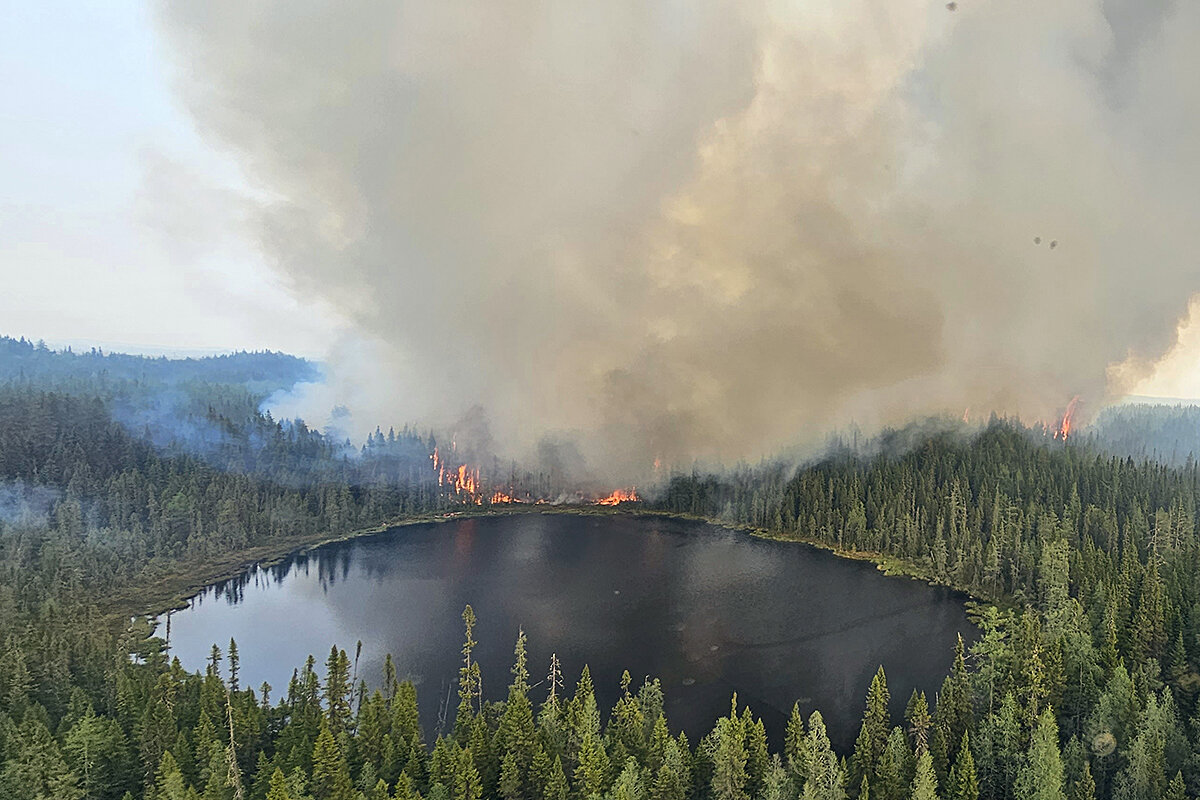
“We’re seeing more and more of these fires because of climate change,” tweeted Prime Minister Justin Trudeau on Wednesday. Though individual fires are difficult to attribute directly to climate change due to their complexity, a 2022 United Nations report included it as one of multiple factors that increase wildfire risks globally. And much of Canada has had a warm and dry spring – a combination that becomes more likely due to warming global temperatures.
By contrast, the U.S. through July “expects a normal to below-normal fire potential in much of the Southwest, California, and Colorado due to snowpack and a wet spring,” says Nick Nauslar, a predictive services meteorologist at the National Interagency Fire Center. The Northwest, he adds in an email, “is likely to have above normal potential.”
How are communities coping with smoke?
Thousands of Canadians have evacuated. The wildfires are also unsettling Americans across the U.S. Midwest and Northeast regions, prompting school closures and early dismissals in New Jersey and delaying flights in cities from Washington to Boston. Officials in both countries urge affected residents to stay inside and use N95-style masks outdoors.
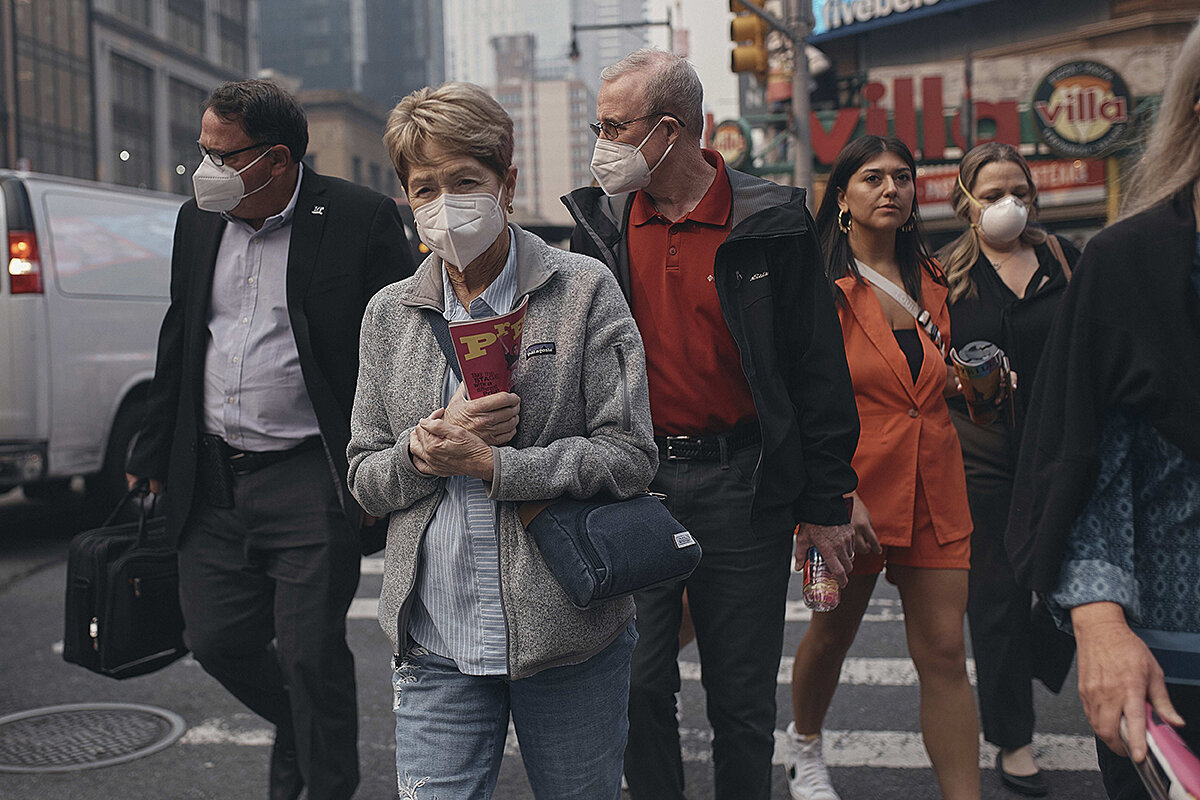
As New York City air quality hit a “hazardous” level Wednesday, Zach Iscol, emergency management commissioner, called for solidarity.
“If you’re young and healthy, please check in on your neighbors,” he said at a press conference. “Make sure that they have the information that they need to stay safe.”
In Toronto, Samantha Green says stepping outside “smells like we’re next to a campfire.” The family physician calls wildfire smoke a “complex soup of air pollutants.”
Speaking of high-efficiency particulate air filters, she says “people should stay inside and ensure that indoor air is clean by closing windows and using a HEPA filter if you have one – or at least ensuring that you have a good-quality filter,” says Dr. Green, president-elect of the Canadian Association of Physicians for the Environment.
Experts recommend citizens check local air quality alerts for help determining daily activities, like whether to go running outside. Canadians can see their city’s status through the federal Air Quality Health Index, while Americans can type their zip code into AirNow.gov.
It could take weeks or more to douse the fires in Quebec and beyond, even with U.S. aid in the firefighting. In the meantime, shifts in wind patterns will be a factor determining air quality.
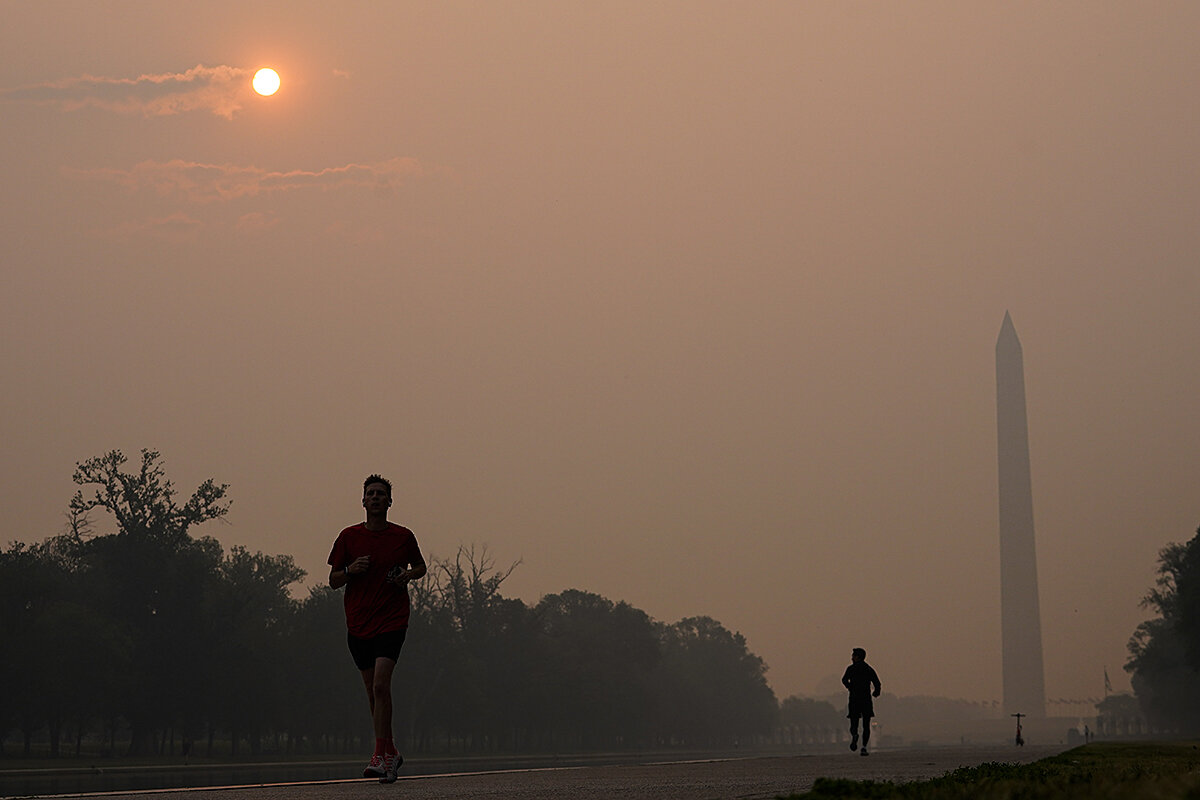
What are potential solutions for mitigating wildfire smoke?
Exposure to massive wildfires “used to be kind of a once-in-a-lifetime thing,” says Keith Bein, an air quality researcher at the University of California, Davis. “Now it’s happening more frequently and it’s becoming almost every season.”
And region. He’s been fielding fire-related questions from friends on the East Coast. That informal knowledge-sharing speaks to lessons the rest of the country might learn from fire veterans out West.
Preparation and public awareness are key, say Western wildfire experts.
“The worst time to respond to a smoke event is while you’re in it,” says Sarah Coefield, an air quality specialist at the Missoula City-County Health Department in Montana. Her community holds an annual Wildfire Smoke Ready Week inspired by one in Washington state.
“We try to kind of flood the airwaves during the early summer,” Ms. Coefield adds. That’s when locals are “starting to think more about the incoming fire season – but it’s not here yet, so they have time to prepare.” She also directs people to MontanaWildfireSmoke.org for additional preparedness tips, including how to assemble a do-it-yourself fan and filter combo.
Another idea in development – public “clean air centers” for those vulnerable to smoke – resembles how “cooling centers” offer respite from extreme heat. California, through a pilot program, has begun to invest in these centers through ventilation system upgrades and purchasing portable air cleaners for buildings like libraries.

Patterns
At French Open, Ukrainian stars seek Russian support
Tensions over Ukraine have sharpened sporting rivalries at the French Open tennis tournament. But some Russian players are showing sympathy for their Ukrainian opponents.

- Quick Read
- Deep Read ( 4 Min. )
As tennis players compete in the French Open this week, the war in Ukraine is casting a shadow over the tournament and highlighting very human dramas among top players from Russia, Ukraine, and Putin-allied Belarus.
For the Ukrainian participants, playing in the knowledge that their friends, family, and loved ones are suffering at home, the imperative to respond to the war has been clear. And they’ve tried to persuade fellow players, especially from Russia and Belarus, that they, too, should speak out.
Very few have done so. Some have made general calls for “peace,” but most prefer to avoid talking about the war at all. They would agree with Belarusian star Aryna Sabalenka, who pleaded on Tuesday that “I’m just a tennis player. I don’t want to be involved in any politics.”
The real question, however, remains whether it is possible for a Ukrainian, Russian, or Belarusian competitor to be “just a tennis player” in the current circumstances.
One leading Russian player, world No. 2 Daniil Medvedev, who has expressed public support for Ukrainian players, clearly has his doubts.
“In this moment,” he said soon after Moscow’s invasion of Ukraine, “you understand that tennis sometimes is not that important.”
At French Open, Ukrainian stars seek Russian support

For decades, Paris in the month of June has meant a jewel for tennis lovers the world over: the French Open, held on the red-clay courts of Roland Garros on the edge of the Bois de Boulogne. One of the sport’s four “majors,” it inevitably inspires headline writers to celebrate the sporting “drama” as top players “battle” for the crown.
Yet this week, a real war – Vladimir Putin’s brutal assault on Ukraine – is casting a shadow over the forehands and backhands, drop shots and lobs in Paris.
And a real, very human drama has been playing out among the top competitors on the women’s side of the game, stars from Russia, Putin-allied Belarus, and Ukraine.
The tension peaked one afternoon this week, in a hard-fought quarterfinal victory by Belarusian star Aryna Sabalenka over Ukrainian Elina Svitolina, the highest-profile match between the players since the invasion.
And it was about more than the tennis.
The two young women had to face a fundamental question – one for which their years of single-minded dedication to tennis cannot have prepared them or their fellow players: how to respond, as individuals, to a savage war neither of them started, neither of them can halt, but which, as citizens of the belligerent countries and worldwide celebrities, neither could simply ignore.

An awkward few seconds at the end of Tuesday’s quarterfinal made it clear that question still hangs in the air at Roland Garros.
Ukraine’s Ms. Svitolina, like all her countrywomen in Paris who faced Russian or Belarusian opponents, had announced beforehand that she would skip the traditional post-match handshake. She walked to her chair, collected her rackets, and left the court.
Ms. Sabalenka, however, stood at the net after winning, as if expecting a handshake, looking quizzically up to her coach and support team as the stadium booed the departing Ms. Svitolina.
For the Ukrainian players, the moral, political, and personal imperative to respond to the war has been clear. They are facing the week-to-week ordeal of playing world-class tournament tennis in the knowledge that their friends, family, and loved ones are being battered by the war.
They’ve used their post-match news conferences to highlight the suffering being inflicted on their country. They’ve sent their winnings home. And they’ve tried to persuade fellow players, especially from Russia and Belarus, that they, too, should speak out.
The situation for the Russian and Belarusian players is almost a mirror image: Their nations are not under attack. But facing up to the war has proved harder.

None has openly supported the war. Some have offered a general call for “peace.” But almost none of them has condemned the Russian invasion or Belarus’ supportive role in it, and instead they have tried to avoid talking about it at all.
There have been a few exceptions, most prominently Russia’s top-10 woman player Daria Kasatkina. She has denounced the war, and said on the eve of the French Open that Ukrainian players “have a lot of reasons not to shake hands with us.”
Both after defeating one Ukrainian, Lesia Tsurenko, and then after losing to Ms. Svitolina one round later, Ms. Kasatkina simply walked to her chair without a handshake. She offered a smile, a discreet wave, and a supportive thumbs-up to her opponents as she left the court.
But it is Ms. Sabalenka’s response that has been more typical of the Russians and Belarusians: an insistence the war has nothing to do with her, and that while she wants it to end, her focus is on tennis.
Some fraught encounters with the media in Paris, though, have suggested that the war may be raising difficult personal questions for her as well.
At a post-match news conference early in the tournament, a Ukrainian reporter called on her to renounce her past support for Belarusian President Alexander Lukashenko.

Ms. Sabalenka declined to answer. Then she stopped doing full-scale press conferences, saying she felt “not safe” and had to protect her own mental health.
After Tuesday’s match, however, she did attend a standard news conference, and she tried to explain how hard she was finding it to respond to the war. “I’m just a tennis player, a 25-year-old tennis player,” she said almost plaintively. “I don’t want to be involved in any politics. I just want to be a tennis player.”
Still, she did go a little further toward taking a stand, saying not only that she wanted an end to the war, but that “I don’t want my country to be involved in any conflict. I don’t support Lukashenko right now.”
The real question, however, remains whether it is possible for a Ukrainian, Russian, or Belarusian at Roland Garros, and next month at Wimbledon, to be “just a tennis player” in the current circumstances.
One leading Russian player, world No. 2 Daniil Medvedev, who has expressed public support for Ukrainian players, clearly has his doubts.
“In this moment,” he said soon after Moscow’s invasion of Ukraine, “you understand that tennis sometimes is not that important.”

Books
From MLK to Black Power: Books trace Civil Rights Movement
As more primary sources become available – including declassified government documents – the history of the Civil Rights Movement is becoming richer and fuller.

- Quick Read
- Deep Read ( 6 Min. )
-
By Barbara Spindel Contributor
“In hallowing King we have hollowed him,” argues Jonathan Eig in his sweeping new book “King: A Life,” the first major biography of Martin Luther King Jr. in years. With the help of newly available sources – from declassified FBI files to recently discovered audiotapes recorded by his widow, Coretta Scott King – the author presents a full portrait.
The cradle-to-grave biography covers King’s relatively privileged Atlanta upbringing, his major political wins, and also his losses.
Two other recent books also offer insights into King – as well as into those who disagreed with him.
In the inspiring “You Have to Be Prepared to Die Before You Can Begin to Live: Ten Weeks in Birmingham That Changed America,” author and journalist Paul Kix charts the 1963 campaign by King’s Southern Christian Leadership Conference to end segregation in Birmingham, Alabama.
Mark Whitaker’s riveting “Saying It Loud: 1966 – The Year Black Power Challenged the Civil Rights Movement” chronicles a turning point, when younger activists like Stokely Carmichael and Huey Newton increasingly repudiated King’s nonviolent tactics.
The continuing pursuit of racial justice in our own time reminds us of the relevance of the Civil Rights Movement, and the lessons this history has to teach. These books are up to the task.
From MLK to Black Power: Books trace Civil Rights Movement

In a sermon titled “Loving Your Enemies” that he delivered often in the early 1960s, Martin Luther King Jr. insisted that he had taken the biblical command to heart. “Put us in jail, and we will go in with humble smiles on our faces, still loving you,” he preached. “Bomb our homes and threaten our children, and we will still love you ... But be assured that we will wear you down by our capacity to suffer.”
In the years leading up to King’s 1968 assassination, he was jailed 29 times, assaulted repeatedly, and threatened constantly. He had to contend not only with die-hard segregationists but, appallingly, with his own government. The FBI, convinced he was being influenced by communists, tapped his phones. When the bureau found evidence not of communism but of the civil rights leader’s marital infidelities, it used that information to try to destroy him.
Jonathan Eig covers this ground, and much more, in his sweeping, edifying “King: A Life,” one of three recent, excellent civil rights-themed books. Eig’s is the first major biography of King in decades, and with the help of newly available sources – from declassified FBI files to recently discovered audiotapes recorded by his widow, Coretta Scott King – the author presents the iconic MLK, who remained steadfastly committed to nonviolent protest, in full.
The two other books focus on smaller pieces of the civil rights story. In the inspiring “You Have to Be Prepared to Die Before You Can Begin to Live: Ten Weeks in Birmingham That Changed America,” author and journalist Paul Kix charts the 1963 campaign by King’s Southern Christian Leadership Conference to end segregation in Birmingham, Alabama. Mark Whitaker’s riveting “Saying It Loud: 1966 – The Year Black Power Challenged the Civil Rights Movement” chronicles a turning point, when younger activists like Stokely Carmichael and Huey Newton increasingly repudiated King’s nonviolent tactics.
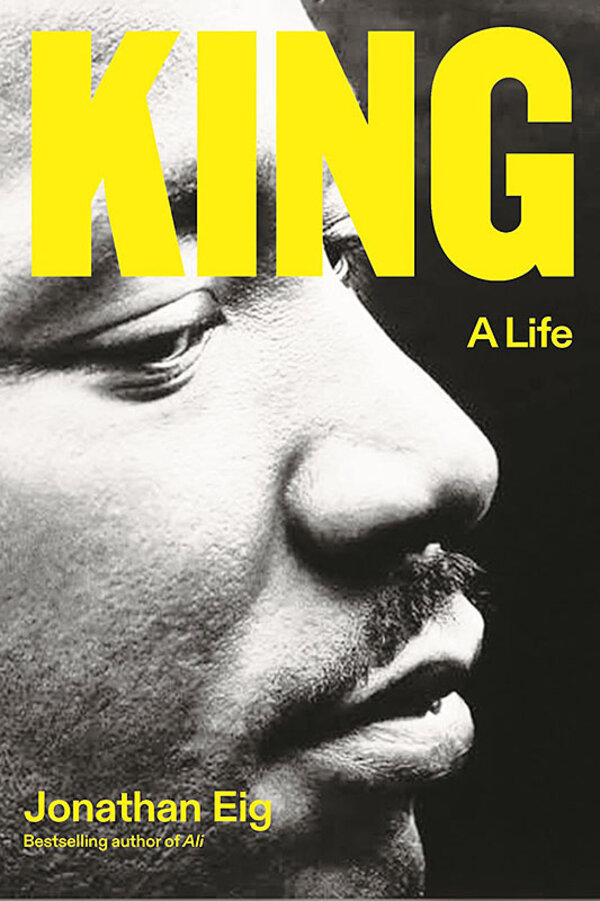
Eig, whose previous subjects include Muhammad Ali and Lou Gehrig, argues that “in hallowing King we have hollowed him”; his humane portrait presents MLK’s frailties alongside his heroism. The cradle-to-grave biography covers King’s relatively privileged Atlanta upbringing and his fraught relationship with his domineering father, which Eig cites as the source of King’s insecurity and occasional depression.
The author’s description of the successful yearlong Montgomery bus boycott, which began in December 1955 and propelled King into a leadership role, is thrilling. The Alabama city was so committed to segregation that it closed all of its public parks for six years rather than integrate them. But at only age 26, King was, Eig writes, “the right man at the right time” to lead the difficult campaign to end segregated seating.
“If we are wrong, the Supreme Court of this nation is wrong,” MLK preached to an adoring crowd. “If we are wrong, the Constitution of the United States is wrong. If we are wrong, God Almighty is wrong.”
King’s stature rose after the boycott, reaching its pinnacle when he delivered his indelible “I Have a Dream” speech on Washington’s National Mall in August 1963. In later years, however, his attempts to take on poverty and housing discrimination in the North cost him liberal white support. He was unprepared for the violent resistance he encountered when he tried to organize protests to desegregate Chicago neighborhoods. “I think the people of Mississippi ought to come to Chicago to learn how to hate,” he said.
His increasingly vocal opposition to the Vietnam War further eroded King’s popularity and led to a bitter break with President Lyndon Johnson, who had signed landmark civil rights legislation in 1964 and 1965. King’s mood grew dark in the months before he died. “He said people expect me to have answers and I don’t have any answers,” his wife later recalled.

Attacks on peaceful marchers
King is a major player in Kix’s book, but not the only one. “You Have to Be Prepared to Die Before You Can Begin to Live” covers the Southern Christian Leadership Conference’s bold plan to, in the author’s words, “subject itself to the full wrath of Birmingham, in the hope that white people outside the city might at last see, through the SCLC’s suffering, the plight of all Blacks in America.” The source of that wrath would be the virulently racist Bull Connor, the city’s longtime public safety commissioner. In large part because of Connor, Kix writes, Birmingham “was not so much a city in 1963 as a site of domestic terror.”
King’s Birmingham colleagues included Wyatt Walker and James Bevel and local pastor Fred Shuttlesworth. The organizers often clashed, and the conflict-averse King could be painfully indecisive. The campaign, which initially flagged, was energized by the participation of children, a fiercely debated decision over which King agonized. After being trained in nonviolent direct action, 973 young marchers were arrested in one day for parading without a permit.
The SCLC gained leverage when it became clear that waves of peaceful protesters would keep coming, despite Connor’s use of fire hoses and police dogs to deter them; the city did not have enough jail space to contain them. (It was from a Birmingham jail, of course, that King wrote the blistering, enduring letter declaring that “injustice anywhere is a threat to justice everywhere.”) The movement gained worldwide sympathy when newspapers published a sickening photograph of a police dog lunging at a Black teenager. The attacks on peaceful marchers finally galvanized John and Robert Kennedy to support civil rights legislation.
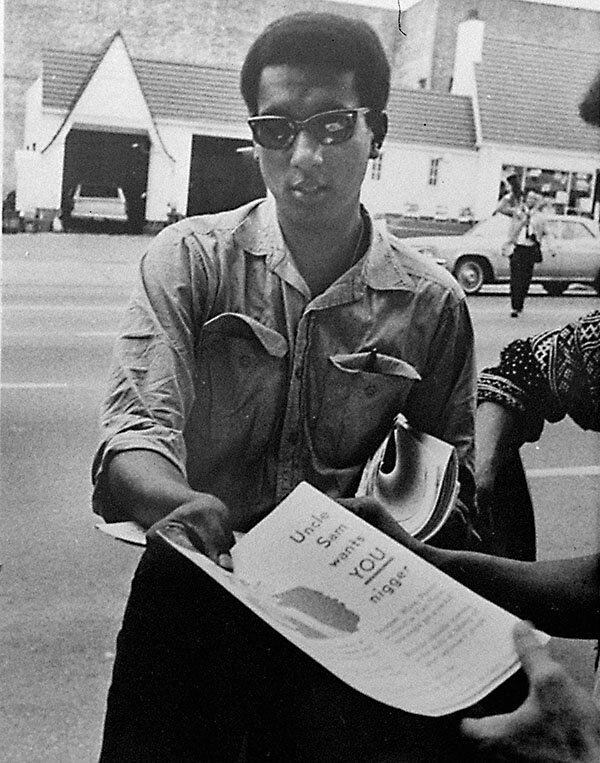
Rise of Black Power
In “Saying It Loud,” journalist and author Whitaker focuses on a more radical set of activists, many of whom had lost patience with King’s slow and steady approach as movement leader. “The presence of Malcolm X hovered over them,” Whitaker writes. For them, King’s mantra of nonviolence had became synonymous with ineffectuality.
“We’ve been saying ‘Freedom Now’ for six years and we ain’t got nothing,” Carmichael, the most prominent figure in Whitaker’s book, famously told an energized Mississippi crowd in1966. “What we’re gonna start saying now is: ‘Black Power’!”
The firebrand had become president of the Student Nonviolent Coordinating Committee just weeks before when the younger members of the group ousted the moderate John Lewis. (After a painful debate, SNCC later voted to expel all white members from the organization.) Carmichael’s defiant “Black Power” chant, the author writes, “made him a nationally recognized figure virtually overnight.” It helped inspire Newton and Bobby Seale to arm themselves and create the Black Panther Party for Self-Defense in California.
Whitaker insightfully captures the young activists’ frustration with King – many of them mocked him with the nickname “Da Lawd” – as well as their sense that nonviolence left them vulnerable to white brutality. He follows the threads of Black power from the establishment of Black studies programs in higher education to the reactionary rise of conservative politicians like Ronald Reagan, who courted the “white backlash” vote in his 1966 run for California governor.
The Civil Rights Movement will continue to provide fertile material for authors. We can expect new accounts as additional information becomes available. For instance, we’ll learn more about the FBI’s surveillance of King when additional records are unsealed in 2027. Moreover, different perspectives become appreciated over time. Women’s importance to civil rights has long been downplayed, but these histories properly credit women for their contributions, whether it’s Whitaker profiling the formidable SNCC staffer Ruby Doris Smith Robinson or Eig highlighting Coretta Scott King’s own work on behalf of the movement.
Finally, the battles of our own time remind us of the relevance of this history, and the lessons it has to teach. These books are up to the task.

In Pictures
At Odd Pet Vet, quirky critters find love and care
Love comes in many shapes and sizes. At Odd Pet Vet, veterinarians embrace peculiar pets – and the people who adore them.

- Quick Read
- Deep Read ( 3 Min. )
-
JJ Wahlberg Staff writer
Cat and dog owners need look elsewhere: At Odd Pet Vet, just outside of Boston, the staff only takes in “nontraditional” critters.
On any given day, a coterie of birds, reptiles, ferrets, hedgehogs – and even spiders and centipedes – make their way through the Weymouth, Massachusetts, clinic’s doors.
“What we consider an exotic animal is a legal, nontraditional pet,” says Greg Mertz, Odd Pet Vet’s lead veterinarian. “Emphasis on the legal.”
Dr. Mertz has always been fascinated by unusual animals. He’s also the director of the New England Wildlife Center, where wild animals – which cannot be kept as pets – can receive treatment. Odd Pet Vet helps fund the center.
On a recent day, Dr. Mertz switches his focus between a chameleon named Skittles, a rabbit, and a guinea pig. His line of work brings him into contact with a variety of people, some of whom are as interesting as their pets.
In fact, they’re a big part of what draws him to his work.
“Anybody that has odd pets ... they have a nontraditional way of looking at the world,” he says.
At Odd Pet Vet, quirky critters find love and care
Walk into Odd Pet Vet, and you may come across a tortoise, a Flemish Giant rabbit, or a red-tailed hawk. You may also see a few dogs running around, but those belong to the staff. Odd Pet Vet doesn’t treat the furry canines – or cats, for that matter.
The clinic only treats “exotic” animals: birds, reptiles, mammals like ferrets and hedgehogs, and even spiders and centipedes.
“What we consider an exotic animal is a legal, nontraditional pet,” says Greg Mertz, Odd Pet Vet’s lead veterinarian. “Emphasis on the legal.”
Dr. Mertz has always been fascinated by unusual animals. He’s also the director of the New England Wildlife Center, where wild animals – which cannot be kept as pets – can receive treatment. But when people began asking him for help with their exotic critters at home, he launched Odd Pet Vet in 1995. And now, the pet business helps fund the wildlife center.
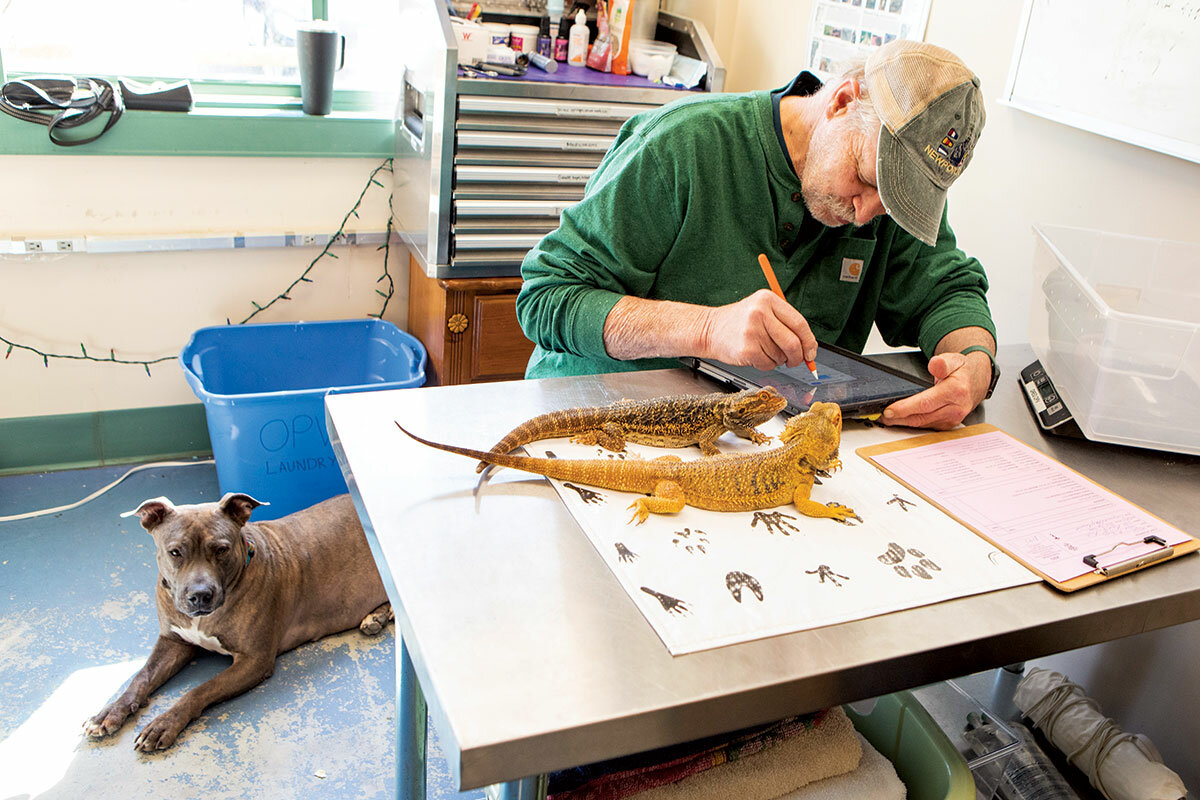
Jarrod McFarland of Providence, Rhode Island, brings in his pet chameleon, Skittles, on a cloudy April day. He cradles the small animal in his outstretched hand, scaly legs in a pattern of scarlet, lime-green, and sky-blue clinging tightly to his fingers.
“I’ve always liked reptiles,” he says. “I liked dinosaurs when I was younger, so I think that’s where it comes from.”
After looking at Skittles, Dr. Mertz switches his focus to a rabbit, and later a guinea pig. Amid the multitude of different species, one idea provides consistent guidance. “Listen to your client,” he says. “It’s always ... you being respectful of the knowledge that they have.”
His line of work brings him into contact with a variety of people, some of whom are as interesting as their pets. In fact, they’re a big part of what draws him to his work.
“Anybody that has odd pets ... they have a nontraditional way of looking at the world,” he says.


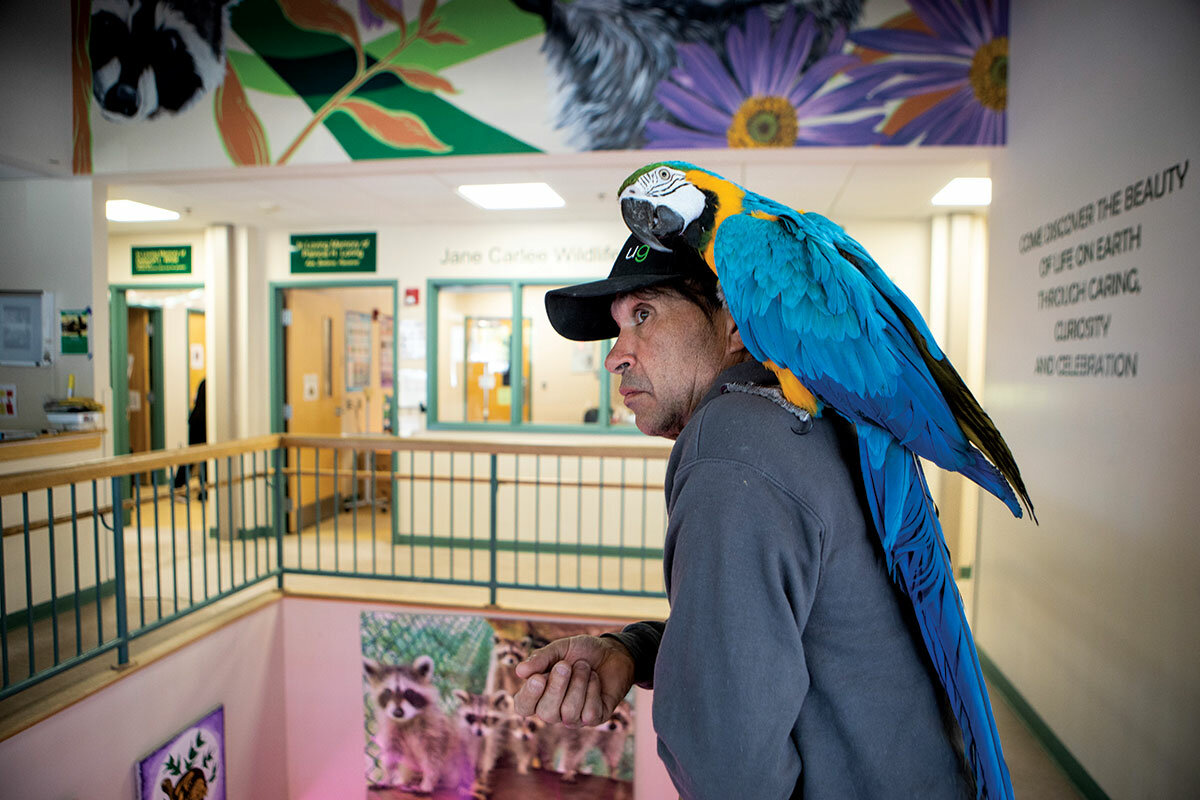


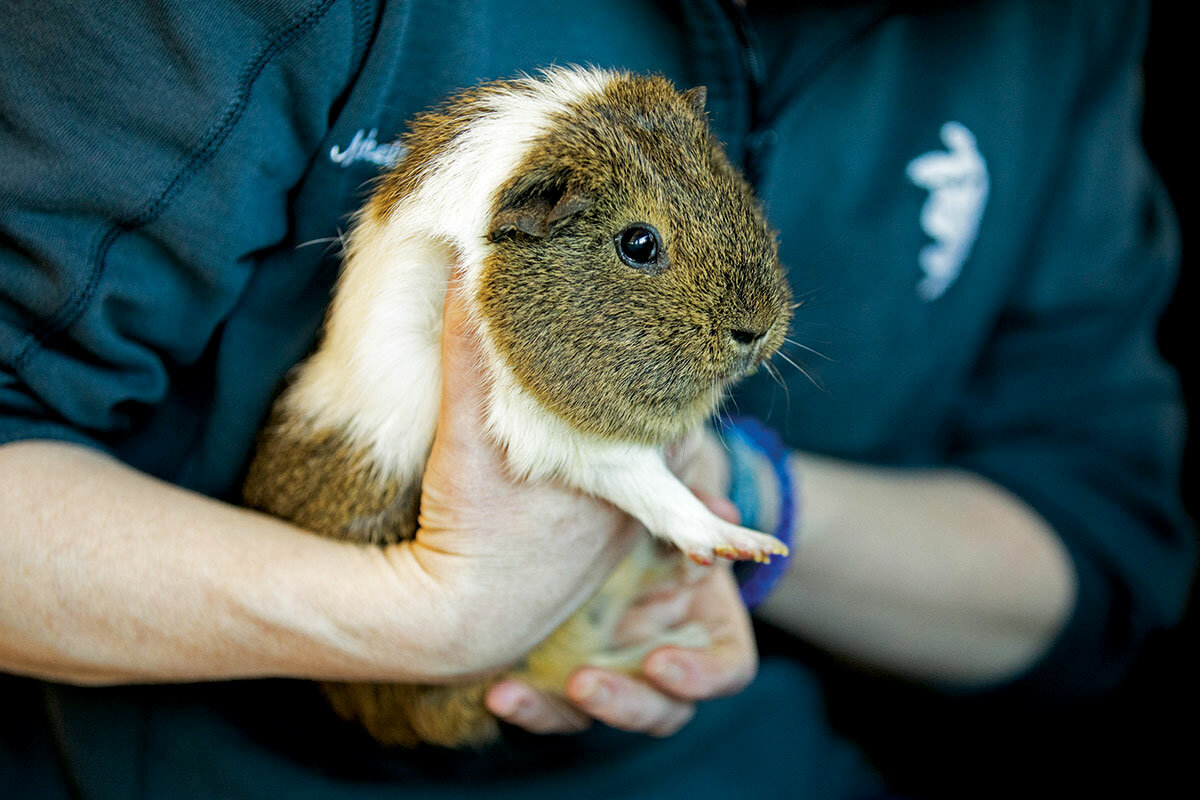

Other headline stories we’re watching
(Get live updates throughout the day.)The Monitor's View
Hunger is rising but so is a key solution: Gender equality
- Quick Read
- Deep Read ( 2 Min. )
-
By the Monitor's Editorial Board
The United Nations reported last month that, among countries without violent conflict, Afghanistan has the highest number of people facing a “catastrophic” level of hunger. Days later, it was no surprise that the U.N. chief took an indirect swipe at Afghanistan, which has seen an acute drop in gender equality since the Taliban takeover in 2021.
“When women & girls have better access to resources, decision-making & education, the result is increased food security for not only themselves, but also their families and their communities,” tweeted Secretary-General António Guterres.
His comment was a nice summary of a growing body of evidence in the past decade. It shows an end to hunger will require honoring the rights of women, such as an ability to own farmland. The proof is in an analysis of 109 countries from 2018-2021 by CARE International. “Gender equality is highly connected to food and nutrition security,” the report found.
In 2022, the world saw the highest rate of food insecurity in the past seven years. The main drivers were climate change, inflation, the war in Ukraine, and the pandemic. Yet the main solution may be gender equality.
Hunger is rising but so is a key solution: Gender equality

The United Nations reported last month that, among countries without violent conflict, Afghanistan has the highest number of people (2.8 million) facing a “catastrophic” level of hunger. Days later, it was no surprise that the U.N. chief took an indirect swipe at Afghanistan – which has seen an acute drop in gender equality since the Taliban takeover in 2021.
“When women & girls have better access to resources, decision-making & education, the result is increased food security for not only themselves, but also their families and their communities,” tweeted Secretary-General António Guterres.
His comment was a nice summary of a growing body of evidence in the past decade that shows an end to hunger will require honoring the rights of women – such as an ability to own farmland, inherit wealth, and have government agricultural agents who are female.
The proof is in an analysis of 109 countries from 2018-2021 by CARE International. “Gender equality is highly connected to food and nutrition security at a local, national, and global level,” the report found. “The more gender inequality there is in a country, the hungrier and more malnourished people are.”
Hunger will take a big hit once more countries treat women as equals. A report in April by the U.N. Food and Agriculture Organization predicted that the number of food-insecure people would fall by 45 million if the gender gap in farm productivity and wages for food-related jobs were reduced.
In Africa, where 66% of women’s employment is in agri-food systems, progress has been notable. “Africa has taken significant leaps forward in girls’ education, women’s political representation, and entrepreneurship,” said Ousmane Badiane, co-chair of the Malabo Montpellier Panel, a body of expert who evaluated the continent’s steps on gender equality. One example: Men in Kenya who took legal training on women’s rights were 21% more likely to recognize a woman’s constitutional right to own land than those who did not.
In 2022, the world saw the highest rate of food insecurity in the last seven years, according to a U.N.-led report. The main drivers were climate change, inflation, the war in Ukraine, and the effects of the pandemic. Yet the main solution may be a shift in attitude on gender equality. Afghanistan’s acute hunger only proves the point.

A Christian Science Perspective
Each weekday, the Monitor includes one clearly labeled religious article offering spiritual insight on contemporary issues, including the news. The publication – in its various forms – is produced for anyone who cares about the progress of the human endeavor around the world and seeks news reported with compassion, intelligence, and an essentially constructive lens. For many, that caring has religious roots. For many, it does not. The Monitor has always embraced both audiences. The Monitor is owned by a church – The First Church of Christ, Scientist, in Boston – whose founder was concerned with both the state of the world and the quality of available news.
Not fearing, but revering God
- Quick Read
- Read or Listen ( 3 Min. )
-
By Vicki Turpen
When fear comes knocking, whether the threat is big or small, we can find comfort and security by turning our attention to a deep love for God.
Not fearing, but revering God
It was 1962, and much of the United States was gripped by fear, knowing that the Soviet Union was in the process of installing nuclear missiles on the island of Cuba. Although the US government was negotiating with the Soviets, the threat felt very real, and people across America were building bomb shelters, fortifying basements, and stocking up on food.
As a new student of Christian Science, I was learning that God is more powerful than both weapons and fear. However, I lived in Albuquerque, New Mexico, where we were warned that there were nuclear materials and perhaps bombs in the nearby mountains and that our city was sure to be a prime target, should there be a conflict.
One morning I was in our tiny bathroom with our two-year-old daughter when all at once we heard the shriek of what sounded like a siren. Panicking, I put my daughter on the floor, covered her with my body, and started to pray. After what seemed like an eternity, the noise stopped, and I realized that the sound had come from a telephone that I had brought into the bathroom, which had been off the hook for too long.
I felt silly for having reacted as I did and realized that I had to address my fear. I decided not to seek answers in the news, or try to follow every snippet of the negotiating process. Instead, I turned to the Bible and to “Science and Health with Key to the Scriptures” by Mary Baker Eddy, the textbook of Christian Science.
I knew that Christ Jesus had proved what he trusted and taught about God and that he had promised his followers that they would be comforted (see John 14:16). I certainly wanted comfort and to not react fearfully or impulsively. I decided to research the word “fear” from a spiritual basis.
The Bible encourages us not to be afraid, and many Bible stories show people overcoming fear and triumphing over fear-inducing situations. The ninety-first Psalm assures us of our safety from mortality and evil and the fears associated with both.
Jesus told his followers, “Fear not, little flock; for it is your Father’s good pleasure to give you the kingdom” (Luke 12:32). He proved this to be true by remaining safe in some dangerous and threatening situations – on a boat in a tempestuous sea, on a cliff when pursued by an angry crowd, and in several other instances.
Digging deeper into the Scriptures, we discover another use of the word “fear” — one that relates to our relationship to God. In Proverbs we read, “The fear of the Lord is the beginning of knowledge” (1:7), and “The fear of the Lord tendeth to life: and he that hath it shall abide satisfied; he shall not be visited with evil” (19:23).
Dictionary definitions of the word “fear” include reverence, respect, veneration, even awe. So, these verses could be seen as counseling people not to be afraid of God, who is Life and Love, and only good, but rather to revere and love Him. Focusing on loving God displaces fear of evil and reveals our inherent security.
I cherished all these insights into the word “fear” and began to revere God more as the only power. My prayers were not only to address my own fears but also to help heal the fear that was being felt in our country. Mrs. Eddy writes, “Good thoughts are an impervious armor; clad therewith you are completely shielded from the attacks of error of every sort. And not only yourselves are safe, but all whom your thoughts rest upon are thereby benefited” (“The First Church of Christ, Scientist, and Miscellany,” p. 210).
As I prayed along with many others in the world, I felt the presence of the Comforter Jesus promised, and I became confident that war was not imminent. I knew there was no need for us to fear one another, because Love governs all. Several days later, negotiations resulted in the missiles being dismantled and removed from Cuba.
When we hear about conflicts around the world, we can ask ourselves, “Which concept of fear will I embrace in my thought?” We can choose to revere God and set aside the temptation to be worried or afraid. Standing confidently in awe of God’s love and power, we can know that divine Love is always victorious.
Adapted from an article published in the Sept. 26, 2022, issue of the Christian Science Sentinel.

Viewfinder
Bluebird delivery

A look ahead
We’re so glad you could join us today. We hope you’ll come back tomorrow, when our Harry Bruinius looks at how Americans are trying to rediscover their spirit of community and connection after a pandemic that left a lingering sense of loneliness.


